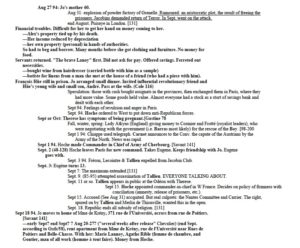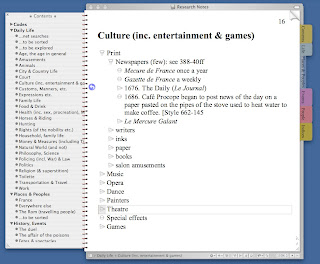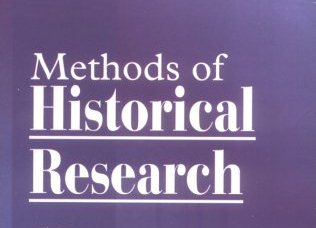First, every document I consult is assigned a number. (See my Sun Court bibliography.)
I begin with recording facts— what happened when—to a timeline on a Word file.
I stagger the entries from the point-of-view of the main character: her personal timeline at the far left, then her family and friends, moving across the page with events in the world coming in on the far right.
This way, on any day, I can see more or less what is happening to my character, her loved ones, her enemies, on the political front, etc. Here is a clip from a page of the Trilogy timeline:
 I will usually put my own thoughts, questions, etc. in grey type, and highlight events of particular interest in yellow. I reference each item by document and page number. (Or try to.)
I will usually put my own thoughts, questions, etc. in grey type, and highlight events of particular interest in yellow. I reference each item by document and page number. (Or try to.)
This particular snapshot is of a file created well over a decade ago. For the timeline for Mistress of the Sun—which grew to over 600 pages; there were times when I thought I was writing a timeline, not a novel—I style-coded the entries, which I could then easily re-format and rearrange to reveal the timeline for The Shadow Queen, which is about the same period, but from a different point-of-view.
Recently, for the Young Adult novel I am writing about Josephine‘s daughter Hortense, I began to use Aeon Timeline. This is a nifty Mac software program taylor-made for writers, but for a timeline as detailed as the one for the Trilogy, I’m starting to think I might be better off sticking with my old Word file. I suspect I will bounce back and forth between the two.
For facts about daily life and individuals, I use Notebook, a Mac outlining software program, again referencing details with book and page number. (The Notebook feature on Word is also useful, and I’ve started to use it instead, although the jury’s not yet out on it.)

An outlining program such Notebook is useful because I can search it easily. (The search facility on Word is powerful as well, but not as flexible as on Notebook. There are pros and cons for each.)
The important thing about a research method—any research method—is evolving a way to store facts so one can easily find what one needs to know.
I’ve taken to using both Evernote and DevonThink Pro as databases. (See Research Tools.) DevonThink is more powerful, but Evernote is wonderfully handy because I can email documents to it. I photograph text and email it directly to Evernote from iPhoto.
And then, of course, there is what I call experiential research: the travel and other research (such as taking a Baroque dancing class, traveling on horseback, or spending a week in a silent monastery). I generally begin with the academic research; then, once I’ve written a draft and know what I need to know, I begin the travel and other research. I write many drafts, continuing to research as I go. If I hit a dry spell, research will invariably replenish me.
(Note: see also the research page on my website.)



Thanks for this Sandra – I’ve printed it off to reference and re-reference as needed.
I’m wondering if you write using Scrivener (http://www.literatureandlatte.com/ – my absolute saviour when it comes to keeping my work organized!) and, if so, whether you’ve heard of their new product, Scapple (http://www.literatureandlatte.com/scapple.php)? I’m not positive Scapple is for me, but the free trial’s probably worth a shot …
Hi keep hearing wonderful things about Scrivner, and I bought it, but I’ve never spent the time to feel comfortable with it. I should use it for a small project and then decide. Scrapple sounds interesting! I’ll have a look. Thanks for the suggestions.